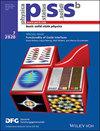4H-SiC 晶体的新型德拜温度模型
IF 1.8
4区 物理与天体物理
Q3 PHYSICS, CONDENSED MATTER
引用次数: 0
摘要
德拜温度是了解固体各种特性(包括其熔化温度)的关键参数。本研究的重点是 4H-SiC 材料,它以宽带隙和高热导率著称,是大功率电子设备的理想材料。计算 4H-SiC 的各种物理参数,包括德拜温度,对于半导体制造至关重要。然而,现有的 Debye 模型并不适合计算 4H-SiC 的 Debye 温度。因此,在使用 Debye 模型的同时还使用了声子计算,以建立一个确定 4H-SiC 的 Debye 温度的新模型。这项研究确定了一个最佳温度范围,即 150 至 160 K 之间的 "T150 "模型,该温度范围产生的 Debye 温度与实验值一致。本文展示的新开发的 "T150 "模型有可能用于确定掺杂的 4H-SiC 、其他多类型 4H-SiC 以及其他半导体材料的德拜温度,从而拓宽了其在材料科学领域的应用范围。本文章由计算机程序翻译,如有差异,请以英文原文为准。

New Debye Temperature Model of 4H‐SiC Crystal
The Debye temperature is a crucial parameter in understanding various properties of solids, including their melting temperature. This study focuses on 4H‐SiC, a material renowned for its wide bandgap and high thermal conductivity, making it ideal for high‐power electronic devices. Calculating various physical parameters for 4H‐SiC, including the Debye temperature, is crucial for semiconductor fabrication. However, it is observed that existing Debye models are unsuitable for computing the Debye temperature of 4H‐SiC. Therefore, phonon calculations alongside the Debye model to establish a new model for determining the Debye temperature of 4H‐SiC are used. This research has identified an optimal temperature range, referred to as the ‘T150’ model, between 150 and 160 K, which yields a Debye temperature consistent with experimental values. The newly developed “T150” model, demonstrated herein, holds the potential for determining the Debye temperatures of doped 4H‐SiC, other polytypes of 4H‐SiC, and other semiconductor materials, broadening its applicability in material science.
求助全文
通过发布文献求助,成功后即可免费获取论文全文。
去求助
来源期刊
CiteScore
3.30
自引率
6.20%
发文量
321
审稿时长
2 months
期刊介绍:
physica status solidi is devoted to the thorough peer review and the rapid publication of new and important results in all fields of solid state and materials physics, from basic science to applications and devices. Being among the largest and most important international publications, the pss journals publish review articles, letters and original work as well as special issues and conference contributions.
physica status solidi b – basic solid state physics is devoted to topics such as theoretical and experimental investigations of the atomistic and electronic structure of solids in general, phase transitions, electronic and optical properties of low-dimensional, nano-scale, strongly correlated, or disordered systems, superconductivity, magnetism, ferroelectricity etc.

 求助内容:
求助内容: 应助结果提醒方式:
应助结果提醒方式:


